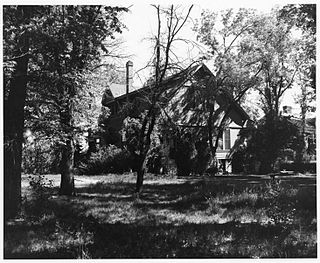
The Francis G. Newlands Home is a historic house at 7 Elm Court in Reno, Nevada, United States. Built in 1890, it is the former mansion of United States Senator Francis G. Newlands (1846-1917), a driving force in passage of the 1902 Newlands Reclamation Act. It was declared a National Historic Landmark in 1963 and listed on the National Register of Historic Places in 1966. The house is privately owned and is not open to the public.

The James Nichols House is a historic house at 273 Pearl Street in Reading, Massachusetts. Built c. 1795, this 1-1/2 story gambrel-roofed house is built in a vernacular Georgian style, and is a rare local example of the style. The house was built by a local shoemaker and farmer who was involved in a religious dispute that divided the town. The house was listed on the National Register of Historic Places in 1984.

The William W. Early House is a Queen Anne-style house located at Brandywine in Prince George's County, Maryland, United States, and is privately owned. It was constructed in 1907. According to a 1989 Historic American Buildings Survey report on the house, "The William W. Early House is probably the best example of turn-of-the-century Queen Anne-style domestic architecture in the county."
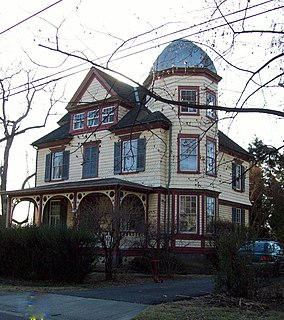
The Harry Smith House is a Queen Anne-style frame dwelling, built in 1890. It stands on one of the original streets platted in the 1889 railroad suburb subdivision of Riverdale Park, Prince George's County, Maryland located northeast of Washington, D.C.. The home is representative of the transition in domestic architecture between the Queen Anne style of the 1880s and the popular plan of the turn of the 20th century. Its owners were a middle class, government worker family, the Smiths, who owned it from the time when the developer sold it until the middle of the 20th century.

25 Avon Street is a historic house, and is significant as one of the more elaborate Queen Anne Victorian houses in the town of Wakefield, Massachusetts.
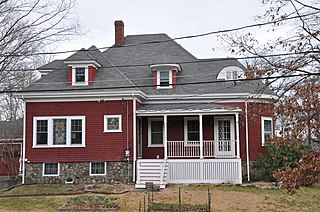
The House at 2 Nichols Street in Wakefield, Massachusetts, is a well-preserved, architecturally eclectic house built in the 1890s. The 1 1⁄2-story frame house has elements of Tudor Revival, Queen Anne, and Colonial Revival styling, and is one of two identical houses built by local builder Berndt Heurlin. It has a hip roof, but transverse gables, one of which has a rounded bay, giving it a Queen Anne feel. The foundation exterior is fieldstone, and there are several stained glass windows.
Upson House may refer to:

The Charles Whitaker House is a historic building located on the east side of Davenport, Iowa, United States. It has been listed on the National Register of Historic Places since 1985.

The George Angus and Martha Ansil Beebe House is a historic house located in Provo, Utah, United States. It is listed on the National Register of Historic Places.

The Joseph H. Gray House, at 457 Court St. in Reno, Nevada, United States, is a historic house that was built in 1911. It includes Colonial Revival details in a form having Queen Anne-style massing. It was listed on the National Register of Historic Places in 1987. The listing included two contributing buildings.

The Tyson House, at 242 W. Liberty St. in Reno, Nevada is a historic house that was built during 1904-1906 and that was once owned by the family of Nevada senator Francis Newlands. It includes Colonial Revival elements but is primarily of Queen Anne architectural style.
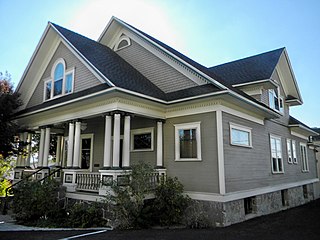
The Charles H. Burke House, at 36 Stewart St. in Reno, Nevada, is a historic house with Colonial Revival and Queen Anne elements that was designed and built by Charles H. Burke in 1908.

The Burke–Berryman House, at 418 Cheney St. in Reno, Nevada, is a historic house with elements of Queen Anne and Colonial Revival architecture. It was built c.1909-10 as a rental house in the "Burke's Addition" area of Reno, developed by Charles H. Burke.
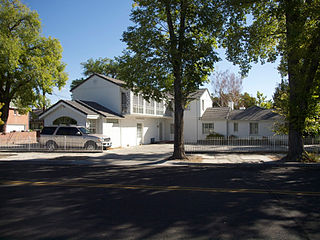
The Luella Garvey House, at 589-599 California Ave. in Reno, Nevada, United States.
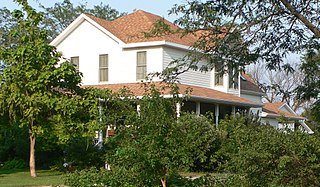
The Raesly House is a house in Plankinton, South Dakota. It is designed in the Queen Anne style of architecture. It was constructed c. 1883 and added to the National Register in 2004.

The Nortonia Boarding House, at 150 Ridge St. in Reno, Nevada, was built in c.1900-1904. In 1906 it was purchased by Norton, who changed it to a boarding house, and it was also extended then. It is primarily Queen Anne in style but includes elements of Colonial Revival architecture as well. It was listed on the National Register of Historic Places in 1983. It is notable as "one of the best" surviving Queen Anne houses in Reno.

The Patrick Ranch House, at 1225 Gordon Ave. in Reno, Nevada, was built c.1901 and has been described as "a charming, turn-of-the-century, Folk Victorian home with Queen Anne attributes." It was listed on the National Register of Historic Places in 2003. It was deemed significant "for its role in Reno's community planning and development history" and "as an excellent example of Folk Victorian/Queen Anne style of architecture, which is becoming increasingly rare."

The William I. and Magdalen M. Goff House, also known as the Goff House, is a residential structure in El Reno, Oklahoma. Listed on the National Register of Historic Places in 1988, it was built in 1901 and is a landmark in the city of El Reno. It has undergone very few exterior changes since its construction before statehood.

The Peter Stauer House is a historic building located in McGregor, Iowa, United States. Completed in 1882, it is a two-story brick structure that features stone details, an attached frame wing on the back, a cross gable roof, and a wooden porch. Local architect Elias White Hale Jacobs designed the house in the Queen Anne style. Two prominent McGregor businessmen, Peter Stauer and J. A. Ramage, owned it consecutively. The house was listed on the National Register of Historic Places in 2003.

The Benoit Apartments area pair of apartment houses at 439 and 447 Pearl Street in St. Johnsbury, Vermont. Both were built around the turn of the 20th century, and are respectively well-preserved examples of Colonial Revival and Queen Anne architecture with a long period of common ownership. They were each listed individually on the National Register of Historic Places in 1994, in listings that included street numbers current to that period.
























